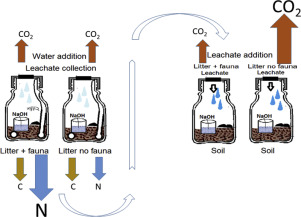当前位置:
X-MOL 学术
›
Appl. Soil Ecol.
›
论文详情
Our official English website, www.x-mol.net, welcomes your
feedback! (Note: you will need to create a separate account there.)
Soil fauna reduce soil respiration by supporting N leaching from litter
Applied Soil Ecology ( IF 4.8 ) Pub Date : 2020-09-01 , DOI: 10.1016/j.apsoil.2020.103585 Jan Frouz , Kateřina Novotná , Lenka Čermáková , Martin Pivokonský
Applied Soil Ecology ( IF 4.8 ) Pub Date : 2020-09-01 , DOI: 10.1016/j.apsoil.2020.103585 Jan Frouz , Kateřina Novotná , Lenka Čermáková , Martin Pivokonský

|
Abstract It has been suggested that, in addition to consuming litter and releasing C via respiration, soil fauna may also indirectly increase overall C loss from soil by causing the priming effect. This is based on the assumption that fauna increases the amount of liable C rather than N in litter leachate. An increase in the labile C would increase soil respiration via the priming effect, while an increase in N in leachates would presumably have the opposite effect (negative priming, decrease of respiration). Here we used a microcosm experiment to study the effects of the presence or absence of two species of soil fauna (the collembolan Folsomia candida and the enchytraeid Enchytraeus crypticus) used alone or in combination, on: 1) the litter respiration of five plants (Alnus glutinosa, Calamagrostis epigejos, Quercus robur, Salix caprea, and Picea omorika), 2) the loss of C and N by leaching from the same litter during a one-year laboratory experiment, and 3) the effect of these leachates on microbial respiration of the soil underlying the litter layer. Litter-based respiration in microcosms was unaffected by soil fauna. The fauna did not affect the leaching of C, but significantly increased the leaching of N. These effects were strongest in the early stages of decomposition. Leachates collected from fauna and no fauna treatment were then applied to the soil underlying the litter. The soil supplied by leachate from fauna treatments showed significantly lower respiration than the soil supplied by no fauna treatments leachates. This suggests that the fauna effect on litter leachate may reduce soil respiration.
中文翻译:

土壤动物通过支持从枯枝落叶中浸出氮来减少土壤呼吸
摘要 有人提出,除了消耗凋落物和通过呼吸释放碳外,土壤动物群还可能通过引发效应间接增加土壤中碳的整体流失。这是基于动物群增加垃圾渗滤液中易受污染的 C 量而不是 N 量的假设。不稳定 C 的增加会通过启动效应增加土壤呼吸,而渗滤液中 N 的增加可能会产生相反的效果(负启动,呼吸减少)。在这里,我们使用了一个缩影实验来研究两种土壤动物群(弹跳木 Folsomia candida 和 enchytraeid Enchytraeus crypticus)的存在或不存在对单独或组合使用的影响:1)五种植物(桤木)的凋落物呼吸glutinosa, Calamagrostis epigejos, Quercus robur, Salix caprea, 和 Picea omorika),2) 在为期一年的实验室实验中从同一枯枝落叶中浸出的 C 和 N 损失,以及 3) 这些渗滤液对枯枝落叶层下土壤微生物呼吸的影响。微观世界中基于凋落物的呼吸不受土壤动物群的影响。动物群对 C 的浸出没有影响,但显着增加了 N 的浸出。这些影响在分解的早期阶段最强。然后将从动物群中收集的渗滤液和未经动物群处理的渗滤液施加到垃圾下面的土壤中。由动物群处理渗滤液提供的土壤比没有动物群处理渗滤液提供的土壤显示出显着较低的呼吸作用。这表明动物群对垃圾渗滤液的影响可能会减少土壤呼吸。2) 在为期一年的实验室实验中从同一凋落物浸出的 C 和 N 损失,以及 3) 这些浸出液对凋落物层下土壤微生物呼吸的影响。微观世界中基于凋落物的呼吸不受土壤动物群的影响。动物群不影响 C 的浸出,但显着增加了 N 的浸出。这些影响在分解的早期阶段最强。然后将从动物群中收集的渗滤液和未经动物群处理的渗滤液施加到垃圾下面的土壤中。由动物群处理渗滤液提供的土壤比没有动物群处理渗滤液提供的土壤显示出显着较低的呼吸作用。这表明动物群对垃圾渗滤液的影响可能会减少土壤呼吸。2) 在为期一年的实验室实验中从同一凋落物浸出的 C 和 N 损失,以及 3) 这些浸出液对凋落物层下土壤微生物呼吸的影响。微观世界中基于凋落物的呼吸不受土壤动物群的影响。动物群不影响 C 的浸出,但显着增加了 N 的浸出。这些影响在分解的早期阶段最强。然后将从动物群中收集的渗滤液和未经动物群处理的渗滤液施加到垃圾下面的土壤中。由动物群处理渗滤液提供的土壤比没有动物群处理渗滤液提供的土壤显示出显着较低的呼吸作用。这表明动物群对垃圾渗滤液的影响可能会减少土壤呼吸。3) 这些渗滤液对凋落物层下土壤微生物呼吸的影响。微观世界中基于凋落物的呼吸不受土壤动物群的影响。动物群不影响 C 的浸出,但显着增加了 N 的浸出。这些影响在分解的早期阶段最强。然后将从动物群中收集的渗滤液和未经动物群处理的渗滤液应用于垃圾下面的土壤。由动物群处理渗滤液提供的土壤比没有动物群处理渗滤液提供的土壤显示出显着较低的呼吸作用。这表明动物群对垃圾渗滤液的影响可能会减少土壤呼吸。3) 这些渗滤液对凋落物层下土壤微生物呼吸的影响。微观世界中基于凋落物的呼吸不受土壤动物群的影响。动物群不影响 C 的浸出,但显着增加了 N 的浸出。这些影响在分解的早期阶段最强。然后将从动物群中收集的渗滤液和未经动物群处理的渗滤液施加到垃圾下面的土壤中。由动物群处理渗滤液提供的土壤比没有动物群处理渗滤液提供的土壤显示出显着较低的呼吸作用。这表明动物群对垃圾渗滤液的影响可能会减少土壤呼吸。但显着增加了 N 的浸出。这些影响在分解的早期阶段最强。然后将从动物群中收集的渗滤液和未经动物群处理的渗滤液施加到垃圾下面的土壤中。由动物群处理渗滤液提供的土壤比没有动物群处理渗滤液提供的土壤显示出显着较低的呼吸作用。这表明动物群对垃圾渗滤液的影响可能会减少土壤呼吸。但显着增加了 N 的浸出。这些影响在分解的早期阶段最强。然后将从动物群中收集的渗滤液和未经动物群处理的渗滤液施加到垃圾下面的土壤中。由动物群处理渗滤液提供的土壤比没有动物群处理渗滤液提供的土壤显示出显着较低的呼吸作用。这表明动物群对垃圾渗滤液的影响可能会减少土壤呼吸。
更新日期:2020-09-01
中文翻译:

土壤动物通过支持从枯枝落叶中浸出氮来减少土壤呼吸
摘要 有人提出,除了消耗凋落物和通过呼吸释放碳外,土壤动物群还可能通过引发效应间接增加土壤中碳的整体流失。这是基于动物群增加垃圾渗滤液中易受污染的 C 量而不是 N 量的假设。不稳定 C 的增加会通过启动效应增加土壤呼吸,而渗滤液中 N 的增加可能会产生相反的效果(负启动,呼吸减少)。在这里,我们使用了一个缩影实验来研究两种土壤动物群(弹跳木 Folsomia candida 和 enchytraeid Enchytraeus crypticus)的存在或不存在对单独或组合使用的影响:1)五种植物(桤木)的凋落物呼吸glutinosa, Calamagrostis epigejos, Quercus robur, Salix caprea, 和 Picea omorika),2) 在为期一年的实验室实验中从同一枯枝落叶中浸出的 C 和 N 损失,以及 3) 这些渗滤液对枯枝落叶层下土壤微生物呼吸的影响。微观世界中基于凋落物的呼吸不受土壤动物群的影响。动物群对 C 的浸出没有影响,但显着增加了 N 的浸出。这些影响在分解的早期阶段最强。然后将从动物群中收集的渗滤液和未经动物群处理的渗滤液施加到垃圾下面的土壤中。由动物群处理渗滤液提供的土壤比没有动物群处理渗滤液提供的土壤显示出显着较低的呼吸作用。这表明动物群对垃圾渗滤液的影响可能会减少土壤呼吸。2) 在为期一年的实验室实验中从同一凋落物浸出的 C 和 N 损失,以及 3) 这些浸出液对凋落物层下土壤微生物呼吸的影响。微观世界中基于凋落物的呼吸不受土壤动物群的影响。动物群不影响 C 的浸出,但显着增加了 N 的浸出。这些影响在分解的早期阶段最强。然后将从动物群中收集的渗滤液和未经动物群处理的渗滤液施加到垃圾下面的土壤中。由动物群处理渗滤液提供的土壤比没有动物群处理渗滤液提供的土壤显示出显着较低的呼吸作用。这表明动物群对垃圾渗滤液的影响可能会减少土壤呼吸。2) 在为期一年的实验室实验中从同一凋落物浸出的 C 和 N 损失,以及 3) 这些浸出液对凋落物层下土壤微生物呼吸的影响。微观世界中基于凋落物的呼吸不受土壤动物群的影响。动物群不影响 C 的浸出,但显着增加了 N 的浸出。这些影响在分解的早期阶段最强。然后将从动物群中收集的渗滤液和未经动物群处理的渗滤液施加到垃圾下面的土壤中。由动物群处理渗滤液提供的土壤比没有动物群处理渗滤液提供的土壤显示出显着较低的呼吸作用。这表明动物群对垃圾渗滤液的影响可能会减少土壤呼吸。3) 这些渗滤液对凋落物层下土壤微生物呼吸的影响。微观世界中基于凋落物的呼吸不受土壤动物群的影响。动物群不影响 C 的浸出,但显着增加了 N 的浸出。这些影响在分解的早期阶段最强。然后将从动物群中收集的渗滤液和未经动物群处理的渗滤液应用于垃圾下面的土壤。由动物群处理渗滤液提供的土壤比没有动物群处理渗滤液提供的土壤显示出显着较低的呼吸作用。这表明动物群对垃圾渗滤液的影响可能会减少土壤呼吸。3) 这些渗滤液对凋落物层下土壤微生物呼吸的影响。微观世界中基于凋落物的呼吸不受土壤动物群的影响。动物群不影响 C 的浸出,但显着增加了 N 的浸出。这些影响在分解的早期阶段最强。然后将从动物群中收集的渗滤液和未经动物群处理的渗滤液施加到垃圾下面的土壤中。由动物群处理渗滤液提供的土壤比没有动物群处理渗滤液提供的土壤显示出显着较低的呼吸作用。这表明动物群对垃圾渗滤液的影响可能会减少土壤呼吸。但显着增加了 N 的浸出。这些影响在分解的早期阶段最强。然后将从动物群中收集的渗滤液和未经动物群处理的渗滤液施加到垃圾下面的土壤中。由动物群处理渗滤液提供的土壤比没有动物群处理渗滤液提供的土壤显示出显着较低的呼吸作用。这表明动物群对垃圾渗滤液的影响可能会减少土壤呼吸。但显着增加了 N 的浸出。这些影响在分解的早期阶段最强。然后将从动物群中收集的渗滤液和未经动物群处理的渗滤液施加到垃圾下面的土壤中。由动物群处理渗滤液提供的土壤比没有动物群处理渗滤液提供的土壤显示出显着较低的呼吸作用。这表明动物群对垃圾渗滤液的影响可能会减少土壤呼吸。











































 京公网安备 11010802027423号
京公网安备 11010802027423号